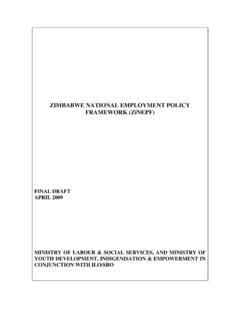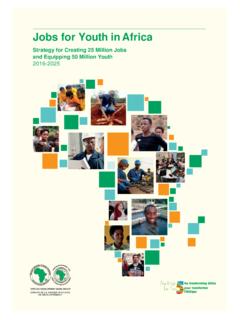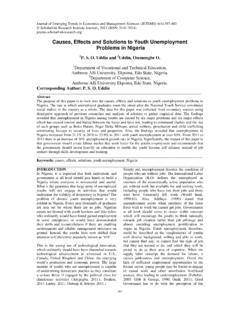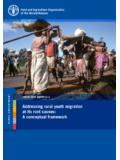Transcription of ILO VALUE CHAIN STUDIES FINAL STUDY REPORT - Skills …
1 ILO VALUE CHAIN STUDIES . FINAL STUDY REPORT . FINAL REPORT PRESENTATION. AGENDA. Welcome and Introductions 10:00-10:05. STUDY Context 10:05-10:20. Overall STUDY Findings 10:20-10:40. VALUE CHAIN Selection 10:40-11:10. Challenge Fund Design 11:10-11:30. Recommended Next steps 11:30- 12:00. TOR: Desk STUDY To review relevant and recent VALUE CHAIN STUDIES and projects . Review of all previous STUDIES and VALUE CHAIN projects identifying economic sectors that have potential for private sector-led, employment intensive and environmentally sustainable growth especially in rural areas Development of subsector criteria select 5 subsector VALUE chains, in which Skills development is a critical success factor for productivity, growth and competitiveness. TOR: FINAL REPORT VALUE CHAIN mapping characterise the product market to include sources of raw materials, buyers, mechanisms for information flow within the VALUE CHAIN , and key supporting services (energy, transportation, training etc).
2 Brief product and industry profile that should Market, production and trade data Key drivers of the demand for the product Identify key segments and activities in the CHAIN where poor performance or inefficiencies due to shortage of Skills severely undermine the competitiveness of the entire VALUE CHAIN What did we do? Analysed literature on Zimbabwe's economic performance Reviewed subsector STUDIES conducted in Zimbabwe strong bias to agriculture (rural, stage of economy, ease of entry). Developed customised selection criterion VALUE CHAIN maps & channels Driving forces & interventions Developed customised subsector reports Five subsectors Designed a challenge fund framework for ILO. Rationale Governance Management Performance management FINAL REPORT Contents Poverty and unemployment in Zimbabwe Youth and youth challenges in Zimbabwe Highlights of selected subsectors in Zimbabwe.
3 Key driving forces and opportunities for intervention Geographical distribution of subsectors Overall intervention recommendation Challenge Fund design Indicative subsector development indicators Indicative participants in the VALUE chains Next steps Specifics for setting up the challenge fund AGENDA. Welcome and Introductions 10:00-10:05. STUDY Context 10:05-10:20. FINAL REPORT Summary 10:20-10:40. VALUE CHAIN Selection 10:40-11:10. Recommendations 11:10-11:30. Implications & Next steps 11:30- 12:00. Economy of Zimbabwe Focus: Understand the key drivers of the economy and how the structural demand and supply issues impact on VALUE chains targeted for youth economic empowerment What is the structure of the economy? What does the What is the socio-economic context? Analytical Framework economy look like? What is What is the import/export relationship?
4 Constraining the What is the industrial capacity utilisation? economy? What are the psychographic structure? Where are the Which sub sectors are growing and why? pockets of What is the link to youth economic empowerment? opportunities? What are the missing links to that vision? Structure of Economy Focus: Understand the key drivers of the economy and how the structural demand and supply issues impact on VALUE chains targeted for youth economic empowerment Fiscal Policy Review Sectoral Growth Rate Table Sector 2008 Actual Revised 2009 Original 2010 2010 (Revised Est. Projections Projections). Agriculture 10% Manufacturing 10% Mining 40% 31%. Tourism 10% Electricity, Gas and Water Construction Finance and Insurance Real Estate Transport and 4% 3%. Communication Public 0% 3% Administration How should we respond? Low Disposable Incomes How should we respond?
5 Youth in Zimbabwe Key Information Population 13,2m Diaspora 1-1,5m Percent of Youth (>31% of population). (15-29 years). Urban: 31%. Population distribution Rural: 69%. Youth unemployment: 24,9%. Causes of Youth Unemployment Skills mismatches Slow job growth Lack of access to capital Inadequate job matching & signalling AGENDA. Welcome and Introductions 10:00-10:05. STUDY Context 10:05-10:20. Desk STUDY Review Findings 10:20-10:40. VALUE CHAIN Selection 10:40-11:10. Recommendations 11:10-11:30. Implications & Next steps 11:30- 12:00. How should we respond? VALUE CHAIN analysis Focus: Industry growth function of growth of firms in that sector stemming from capitalisation of market opportunities and investments in technology and Skills development of its staff to enhance domestic and international competitiveness. Relevance to target group ( the poor, Decent Work change Criteria SMEs, women, potential?)
6 Workers) Stepping up (productivity, High number of poor or market share, work quality) Size disadvantaged groups Stepping out (new markets, (poor close to markets: jobs, opportunities). producers, workers, Relevance consumers). Participants Intervention Potential? Feasibility of stimulating Considerations VALUE CHAIN development Priorities for decent work through systemic market change. Capacity Feasibility How should we respond? VALUE CHAIN analysis logic Focus: Youth as employees of firms, or suppliers into VALUE chains or as consumers. (opportunities and capacity). VALUE CHAIN analysis Skills development Business linkages as clusters or networks of youth Partnerships with VALUE CHAIN actors How should we respond? VALUE CHAIN selection Focus: four criteria: market potential, economic impact (size), ILO priorities, environmental issues. Summary Information Subsectors Reviewed 20.
7 Subsectors recommended 4. Highly recommended 5. Not recommended 11. How should we respond? VALUE CHAIN selection Focus: four criteria: market potential, economic impact (size), ILO priorities, environmental issues. Subsector Typologies Growth Domestic High growth and Limited Growth opportunities growth and Domestic growth export potential Potential with constraints import potential (6). (5). (6) substitution (3). Beef Cotton Sugar, banana Poultry Groundnuts, Soya Paprika, HVE Maize, domestic Pork Tobacco Groundnuts vegetables vegetables Gold, chrome, Tea, coffee Milk Sorghum, Honey diamonds AGENDA. Welcome and Introductions 10:00-10:05. STUDY Context 10:05-10:20. Desk STUDY Review Findings 10:20-10:40. VALUE CHAIN Selection 10:40-11:10. VALUE CHAIN Maps 11:10-11:30. Implications & Next steps 11:30- 12:00. Zimbabwe Cotton Sub sector Map Local Cotton Local Lint Export Export Markets Seed Cotton Cotton Lint Seed Cotton Processing Cotton Ginneries (n=18).
8 Buying Point Aggregation Post harvest handling Large Scale Smallholder Farmers Commercial (v=250- 290,000 mt) Farmers Production Inputs Research and Development Government and Private Sector Research Channel One Channel 3: Smallholder Contract Grower Channel Large Scale Commercial Outgrower Channel How should we respond? Cotton Summary Subsector Drivers Key Interventions in subsector Work with cotton companies to facilitate cotton input credit recruitment of youth into cotton production scheme (contract farming) models Facilitate provision of training in production Skills , grading and business Hi export demand, management aspects competitive buyers &. good producer prices Training youth in local processing of cotton seed for oil extraction and cotton seed cake for local uses in other enterprises Yield levels and Work in partnership with VALUE CHAIN profitability of farmers players (cotton ginneries, textile firms) to identify youth employment opportunities Zimbabwe Groundnuts Sub sector Map Household National Supermarkets Markets Market Small Large Processors Processing Processors (n=4).
9 (n=4). Smallholder Farmers Domestic Brokers International Brokers Assembly &. Aggregation Shelling Smallholder Farmers Production Inputs Input suppliers (n=5). Channel One Channel 2: Channel 3: Household Consumption Small Processors Channel Large Processor Channel Channel How should we respond? Groundnuts Summary Subsector Drivers Key Interventions in subsector Facilitate formation of youth business groups Access to quality seed and extension support or incorporation of youth into existing production groups Facilitate youth training in production Skills to enhance yields Access to working capital to buy sufficient Explore possibilities of contracting with volumes processing companies to work with youth groups on outgrower arrangements with guarantees for uptake of produce. Explore employment opportunities for youth Enforcement of import with processing companies quality control measures Facilitate the formation of youth trading business enterprises and their access to finance.
10 Zimbabwe Soya Bean Sub sector Map Stock Feed Household oil Export WFP. Markets Market Market Market &margarine Cake Manufacturers Processing (n=4) Soya Chunk Producers Large Processing Companies (n=4). Traders (n=4). Assembly &. Aggregation Traders Importation Brokers (v=50,000 mt). Medium Scale A2 LSCF Farmers &. Production Smallholder Farmers Farmers ARDA Estates Inputs Input suppliers (n=4). Channel One Channel 2: Channel 3: Channel 4: Stock Feed Channel Domestic Household Channel Export Household Domestic Relief Channel Channel How should we respond? Soya Bean Summary Subsector Drivers Key Interventions in subsector Production- Support youth farmers in high Access to capital rainfall natural region II and III to produce good yields of soya bean. Input supply/output buyers- incentivising establishment of local agrodealers to stock Demand higher than supply inputs and buy produce.








